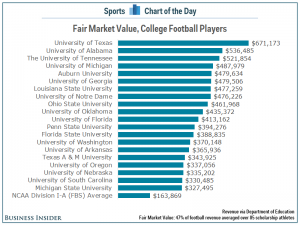Business Insider recently released a study that estimated the value of a college football player if they were considered to be on the free market like you might see in the National Football League (NFL). The way that they were able to calculate the value was using the Collective Bargaining Agreement of the NFL in which the players receive 47% of the total revenue gathered. Business Insider then split the revenue between the players and the college and divided evenly across all of the players with scholarships (85 of them). The photo below shows the value of each player for bigger universities and then the average across D-I football schools.

As you can see, the value of a player is extremely high compared to the fact that college football players make absolutely nothing right now. In a realistic sense, the players might not receive this much revenue if they were to switch to a revenue sharing system because of how much power the NCAA holds over the student-athletes and colleges in general.
It’s absurd that the players are receiving nothing right now since the NCAA is making money off of these players names and jersey numbers. They deserve some sort of compensation for the idea that the NCAA is making money off of them but the players hold simply too little power. The only chance the might have is to unionize but the talks of that happening has slowed down over the past the past couple of years.

Nice choice of an issue. But, the players do get something — access at low or no cost to a college education. Assuming the player does get a degree, most studies indicate this is an investment with a very favorable return — the present value could be more than a million dollars. They, or at least some, also get an option to make the professional league — a rather valuable asset, even if risky. So, it is hard to say they get nothing. Now, they could share in the revenue and then pay full tuition, room, and board — that might be an even better return.